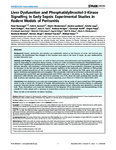Liver Dysfunction and Phosphatidylinositol-3-Kinase Signalling in Early Sepsis: Experimental Studies in Rodent Models of Peritonitis
| dc.contributor.author | Recknagel, P | |
| dc.contributor.author | Gonnert, FA | |
| dc.contributor.author | Westermann, M | |
| dc.contributor.author | Lambeck, S | |
| dc.contributor.author | Lupp, A | |
| dc.contributor.author | Rudiger, A | |
| dc.contributor.author | Dyson, A | |
| dc.contributor.author | Carré, JE | |
| dc.contributor.author | Kortgen, A | |
| dc.contributor.author | Krafft, C | |
| dc.contributor.author | Popp, J | |
| dc.contributor.author | Sponholz, C | |
| dc.contributor.author | Fuhrmann, V | |
| dc.contributor.author | Hilger, I | |
| dc.contributor.author | Claus, RA | |
| dc.contributor.author | Riedemann, NC | |
| dc.contributor.author | Wetzker, R | |
| dc.contributor.author | Singer, M | |
| dc.contributor.author | Trauner, M | |
| dc.contributor.author | Bauer, M | |
| dc.date.accessioned | 2019-09-27T10:58:24Z | |
| dc.date.available | 2019-09-27T10:58:24Z | |
| dc.date.issued | 2012-11 | |
| dc.identifier.issn | 1549-1277 | |
| dc.identifier.issn | 1549-1676 | |
| dc.identifier.other | ARTN e1001338 | |
| dc.identifier.uri | http://hdl.handle.net/10026.1/14939 | |
| dc.description.abstract |
BACKGROUND: Hepatic dysfunction and jaundice are traditionally viewed as late features of sepsis and portend poor outcomes. We hypothesized that changes in liver function occur early in the onset of sepsis, yet pass undetected by standard laboratory tests. METHODS AND FINDINGS: In a long-term rat model of faecal peritonitis, biotransformation and hepatobiliary transport were impaired, depending on subsequent disease severity, as early as 6 h after peritoneal contamination. Phosphatidylinositol-3-kinase (PI3K) signalling was simultaneously induced at this time point. At 15 h there was hepatocellular accumulation of bilirubin, bile acids, and xenobiotics, with disturbed bile acid conjugation and drug metabolism. Cholestasis was preceded by disruption of the bile acid and organic anion transport machinery at the canalicular pole. Inhibitors of PI3K partially prevented cytokine-induced loss of villi in cultured HepG2 cells. Notably, mice lacking the PI3Kγ gene were protected against cholestasis and impaired bile acid conjugation. This was partially confirmed by an increase in plasma bile acids (e.g., chenodeoxycholic acid [CDCA] and taurodeoxycholic acid [TDCA]) observed in 48 patients on the day severe sepsis was diagnosed; unlike bilirubin (area under the receiver-operating curve: 0.59), these bile acids predicted 28-d mortality with high sensitivity and specificity (area under the receiver-operating curve: CDCA: 0.77; TDCA: 0.72; CDCA+TDCA: 0.87). CONCLUSIONS: Liver dysfunction is an early and commonplace event in the rat model of sepsis studied here; PI3K signalling seems to play a crucial role. All aspects of hepatic biotransformation are affected, with severity relating to subsequent prognosis. Detected changes significantly precede conventional markers and are reflected by early alterations in plasma bile acids. These observations carry important implications for the diagnosis of liver dysfunction and pharmacotherapy in the critically ill. Further clinical work is necessary to extend these concepts into clinical practice. Please see later in the article for the Editors' Summary. | |
| dc.format.extent | e1001338-e1001338 | |
| dc.format.medium | Print-Electronic | |
| dc.language | en | |
| dc.language.iso | eng | |
| dc.publisher | Public Library of Science (PLoS) | |
| dc.subject | Animals | |
| dc.subject | Bile Acids and Salts | |
| dc.subject | Biomarkers | |
| dc.subject | Blotting, Western | |
| dc.subject | Cholestasis | |
| dc.subject | Coinfection | |
| dc.subject | Feces | |
| dc.subject | Gene Expression Regulation | |
| dc.subject | Genome-Wide Association Study | |
| dc.subject | Humans | |
| dc.subject | Liver | |
| dc.subject | Liver Diseases | |
| dc.subject | Liver Function Tests | |
| dc.subject | Male | |
| dc.subject | Mice | |
| dc.subject | Mice, Inbred C57BL | |
| dc.subject | Microscopy, Electron, Scanning | |
| dc.subject | Peritonitis | |
| dc.subject | Phosphatidylinositol 3-Kinase | |
| dc.subject | Rats | |
| dc.subject | Rats, Wistar | |
| dc.subject | Sepsis | |
| dc.subject | Signal Transduction | |
| dc.subject | Spectrum Analysis, Raman | |
| dc.subject | Xenobiotics | |
| dc.title | Liver Dysfunction and Phosphatidylinositol-3-Kinase Signalling in Early Sepsis: Experimental Studies in Rodent Models of Peritonitis | |
| dc.type | journal-article | |
| dc.type | Journal Article | |
| dc.type | Research Support, Non-U.S. Gov't | |
| plymouth.author-url | https://www.webofscience.com/api/gateway?GWVersion=2&SrcApp=PARTNER_APP&SrcAuth=LinksAMR&KeyUT=WOS:000311888800004&DestLinkType=FullRecord&DestApp=ALL_WOS&UsrCustomerID=11bb513d99f797142bcfeffcc58ea008 | |
| plymouth.issue | 11 | |
| plymouth.volume | 9 | |
| plymouth.publication-status | Published online | |
| plymouth.journal | PLoS Medicine | |
| dc.identifier.doi | 10.1371/journal.pmed.1001338 | |
| plymouth.organisational-group | /Plymouth | |
| plymouth.organisational-group | /Plymouth/Faculty of Health | |
| plymouth.organisational-group | /Plymouth/Faculty of Health/School of Biomedical Sciences | |
| plymouth.organisational-group | /Plymouth/REF 2021 Researchers by UoA | |
| plymouth.organisational-group | /Plymouth/REF 2021 Researchers by UoA/UoA01 Clinical Medicine | |
| plymouth.organisational-group | /Plymouth/Users by role | |
| plymouth.organisational-group | /Plymouth/Users by role/Academics | |
| plymouth.organisational-group | /Plymouth/Users by role/Researchers in ResearchFish submission | |
| dc.publisher.place | United States | |
| dcterms.dateAccepted | 2012-10-02 | |
| dc.identifier.eissn | 1549-1676 | |
| dc.rights.embargoperiod | Not known | |
| rioxxterms.versionofrecord | 10.1371/journal.pmed.1001338 | |
| rioxxterms.licenseref.uri | http://www.rioxx.net/licenses/all-rights-reserved | |
| rioxxterms.licenseref.startdate | 2012 | |
| rioxxterms.type | Journal Article/Review |


